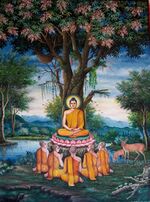Miracles of Gautama Buddha
Topic: Unsolved
 From HandWiki - Reading time: 2 min
From HandWiki - Reading time: 2 min
This article uncritically uses texts from within a religion or faith system without referring to secondary sources that critically analyze them. (October 2017) (Learn how and when to remove this template message) |
According to Buddhist texts, Gautama Buddha possessed several superhuman powers and abilities; however, due to an understanding of the workings of the skeptical mind and how the display of miracles can be abused by unscrupulous people, he reportedly responded to a request for miracles by saying, "...I dislike, reject and despise them,"[1] and refused to comply.
Miraculous birth
It is said that immediately after his birth, he stood up, took seven steps north, and uttered:[2]
"I am chief of the world,
Eldest am I in the world,
Foremost am I in the world.
This is the last birth.
There is now no more coming to be."
Furthermore, every place the baby Buddha placed his foot, a lotus flower bloomed.[2] There is a claim that the Buddha's birth was miraculous via his mother's dream of a white elephant.[3] This does not mean that the Buddha had a virgin birth like the Christian gospels of the birth of Jesus Christ. Buddha's mother was not a virgin, but Buddha was the product of a miraculous conception and a miraculous birth. The Mahāvastu and Lalitavistara explicitly state that no carnal act took place for Buddha's conception; the Buddhacarita is ambiguous. Buddha did also have a miraculous birth. He was born out of the side of his mother.
In the Mahapadana-sutra, Digha ii. 12, is the description of the incarnation of the Vipassī Buddha. "Now Vipassi, brethren, when, as Bodhisat, he ceased to belong to the hosts of the heaven of Delight, descended into his mother’s womb mindful and self-possessed."
Other miracles
Other miracles and powers that Gautama Buddha was said to have possessed and exercised include the six higher knowledges (Abhijna): Iddhi, telepathy, super-hearing, divine seeing, and seeing past lives. These are described in the Mahasihanada Sutta and other suttas in the Pali canon.[4]
The Twin Miracle at Sravasti is also considered as the Buddhist miracle par excellence.[5]
See also
References
- ↑ The Long Discourses of the Buddha, A Translation of the Dīgha Níkāya by Maurice Walshe, Wisdom Publication, Boston 1995, p. 176 [full citation needed]
- ↑ 2.0 2.1 "The Life of the Buddha: The Birth of the Prince". BuddhaNet. http://www.buddhanet.net/e-learning/buddhism/lifebuddha/2lbud.htm.
- ↑ "The Buddha: Story & Teachings". PBS. https://www.pbs.org/thebuddha/birth-and-youth/.
- ↑ Maha-sihanada Sutta
- ↑ Relics of the Buddha, John Strong, Motilal Banarsidass Publisher, 2007 p.177
Bibliography
- Analayo (2016). Levitation in Early Buddhist Discourse, Journal of the Oxford Centre for Buddhist Studies 10, 11-26
- Analayo (2015). The Buddha’s Fire Miracles, Journal of the Oxford Centre for Buddhist Studies 9, 9-42
External links
- parami.org
- palikanon.com
- buddhanet.net
- ukonline.co.uk
- ignca.nic.in
- bartleby.com
- seasite.niu.edu
- suttacentral.net
21 views | Status: cached on September 09 2024 15:17:56
↧ Download this article as ZWI file
 KSF
KSF

